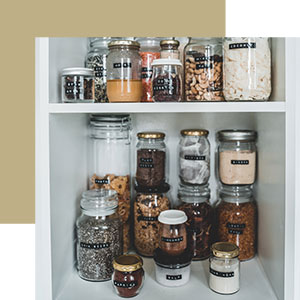Life@Home – September 2021
Many people struggle with where to begin when it comes to being more environmentally conscious. With everyone spending more time at home, why not start there? You don’t have to buy new energy-efficient appliances or install solar panels, but small changes in your home can go a long way in helping reduce your carbon footprint. Here are some simple ways to make your home eco-friendlier, so you can contribute to a sustainable environment while saving money!

1. Avoid Wasting Water
One of the simplest ways to make your home more eco-friendly is to cut down on your water waste. Simply turn off the tap when brushing your teeth, take shorter showers, and check for leaks. Conserving water will not only help the environment but your bills will see a considerable decrease. While we are on the topic of water, switch to a water filter or a reusable water bottle to cut down on single-use plastic bottles.
2. Natural Cleaning Products
It is time to embrace natural cleaning products because they are equally effective, don’t contain any harmful chemicals, and are far better for your health. You may see the price tag on natural cleaning products and be scared off this tip, but many of your daily cleaners can be made at home. Check out this list of homemade cleaners you can make with ingredients you already have.

3. Repurpose Jars
Upcycle your glass jars into many uses throughout your home to start living a zero-waste lifestyle. Many of your favourite grocery items come in glass jars – pasta sauce, pickles, jams – and they make the perfect reusable container once you have finished off the delicious food. These are far better for the environment than plastic containers and will save you cleaning time and money. You can use glass jars in the kitchen for fermenting, storing food, or as shakers. Plus, they can be used all around your house for gardening, storage containers, and fun crafts. The creative opportunities are endless.

4. Eliminate Paper Towels
Paper towels and napkins are an easy go-to in a busy kitchen but switching to cloth towels or rags will save you money and help you live a sustainable lifestyle. These can be re-used many times and easily washed once they get too dirty. Try making your own rags by cutting old shirts or towels into smaller pieces.
5. Reconsider Your Laundry
Start washing your clothes in cold water. Washing with cold water will help cut down your energy consumption as a lot of power goes towards heating the water. Cold water will also help preserve your clothes’ condition and colour. If you want to make your clothes last even longer, hang-dry them! Get an outdoor line or collapsible rack to make hand drying a breeze and let you skip the dryer. But if the dryer is a must, switch single-use dryer sheets or use a reusable wool dryer ball for fewer wrinkles, softer clothes, and less drying time.

6. Plant a Garden
Plants and edible gardens help contribute to a sustainable environment and make a fun hobby! Adding greenery around your home will help produce more oxygen and reduce CO2, making your air cleaner and your décor more beautiful. As well, try adding an herb or vegetable garden to add homegrown flavour to your meals. Edible gardens can be held in any space, big or small, and will save you time and money on trips to the grocery stores. Plus, a backyard garden reduces the use of produce plastic containers. When watering your plants, use collected rainwater to reduce water consumption.

7. Switch to LED Bulbs
Invest in LED light bulbs to help make your home more eco-friendly. These energy-efficient bulbs may have a higher price tag, but they will save you money in the long run by using less energy and lasting longer than incandescent bulbs. With so many LED bulbs to choose from, check out this guide to help your pick your perfect match.

8. Unplug Electronics
This tip is as simple as it sounds– unplug not-in-use electronics. Chargers, TVs, and other electronics use energy even when they are powered down, so unplug them to lower electricity consumption. Try plugging electronics into a power bar to easily power down with no hidden energy consumption. Plus, the power bar’s ‘on’ light makes it obvious when electronics are draining power and makes turning off accessible and painless.

9. Reuse Instead of Buying New
Moving or redecorating? Instead of buying new or throwing away unwanted pieces, try online marketplaces or thrift stores. This is a great, eco-friendly way to easily get rid of or find home pieces while saving money. You can also try refurbishing old items for a fun and creative DIY project that the whole family can participate in.
Monthly Feature
DIY Project: Reusable Oilcloth Bowl Covers
This eco-friendly DIY oilcloth bowl cover will keep food fresh and eliminate wasteful, plastic saran wrap.
Get DIY Project Here
Recipe: Heirloom Tomato and Zucchini Galette with Honey + Thyme
This extraordinary and savoury galette uses ingredients you can grab at your local farmer’s market and will be your new go-to sustainable dish.
Image Credits: Image 1, Image 2, Image 3, Image 4, Image 5, Image 6, Image 7, Image 8, Image 9

 Facebook
Facebook
 X
X
 Pinterest
Pinterest
 Copy Link
Copy Link





